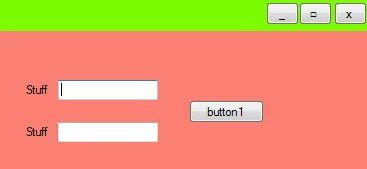我正在创建一个Windows窗体应用程序项目,我想要自定义边框和三个按钮(关闭,最小化和最大化),并且要使用我的设计。我不知道该如何实现这一点,甚至不确定是否可能。如果可以,请告诉我解决方案。谢谢。
5个回答
31
是的,这是可能的,而且不需要额外的库。
首先,隐藏窗口的原始边框。
public Form1()
{
InitializeComponent();
FormBorderStyle = FormBorderStyle.None;
}
接下来,创建一个面板或者其他你想要的东西,包含三个按钮(我知道它很丑,只是为了演示):

然后,使用WindowState将每个按钮分配正确的操作:
private void minimizeButton_Click(object sender, System.EventArgs e)
{
WindowState = FormWindowState.Minimized;
}
private void maximizeButton_Click(object sender, System.EventArgs e)
{
WindowState = FormWindowState.Maximized;
}
private void closeButton_Click(object sender, System.EventArgs e)
{
Close();
}
最后,使用我们的面板使表单可拖动。在类级别添加以下内容:
public const int WM_NCLBUTTONDOWN = 0xA1;
public const int HTCAPTION = 0x2;
[DllImport("User32.dll")]
public static extern bool ReleaseCapture();
[DllImport("User32.dll")]
public static extern int SendMessage(IntPtr hWnd, int Msg, int wParam, int lParam);
然后将它们插入到面板的MouseDown事件中:
private void OnMouseDown(object sender, MouseEventArgs e)
{
if (e.Button == MouseButtons.Left)
{
ReleaseCapture();
SendMessage(Handle, WM_NCLBUTTONDOWN, HTCAPTION, 0);
}
}
现在你有了一个可拖动的表单,带有自己的顶部栏。
如果您希望它可以调整大小,如@PhilWright所提到的,您可以从WndProc捕获WM_NCHITTEST消息,并返回HTBOTTOMRIGHT以触发调整大小:
protected override void WndProc(ref Message m)
{
if (m.Msg == 0x84)
{
const int resizeArea = 10;
Point cursorPosition = PointToClient(new Point(m.LParam.ToInt32() & 0xffff, m.LParam.ToInt32() >> 16));
if (cursorPosition.X >= ClientSize.Width - resizeArea && cursorPosition.Y >= ClientSize.Height - resizeArea )
{
m.Result = (IntPtr)17;
return;
}
}
base.WndProc(ref m);
}
如 @BenVoigt 所述,您可以在按钮/面板上使用 Dock 和 Anchor 属性,以便它们可以适当地调整大小。 如果您不这样做,它们将不会随着表单的调整而改变大小。
- Pierre-Luc Pineault
5
5
补充一下 @Pierre-Luc 的有用解决方案。当窗口最大化后,如果再次单击最大化按钮,如何将其调整回正常位置。以下是代码:
private static bool MAXIMIZED = false;
private void maximizeButton_Click(object sender, System.EventArgs e)
{
if(MAXIMIZED)
{
WindowState = FormWindowState.Normal;
MAXIMIZED = false;
}
else
{
WindowState = FormWindowState.Maximized;
MAXIMIZED = true;
}
}
编辑:如评论中@LarsTech所建议的
private void maximizeButton_Click(object sender, System.EventArgs e)
{
if (this.WindowState != FormWindowState.Maximized)
this.WindowState = FormWindowState.Maximized;
else
this.WindowState = FormWindowState.Normal;
}
- Serge Kishiko
2
3这个信息不需要额外的变量,
if (this.WindowState == FormWindowState.Maximized)已经可以提供这个信息了。 - LarsTech哇,很高兴看到这个帖子在2年后仍然持续着。我当时能够实现相同的解决方案,但我想我没有恰当地阐述我的问题。所以我想要实现一个自定义解决方案,同时保持窗口动画效果,我相信如果我们使用上面的解决方案,我们会失去最小化和最大化动画效果的能力... - Karedia Noorsil
1
一个小细节没有被@Pierre_Luc提到。如果您在面板上添加任何控件,例如标题或图标,则单击这些控件时,窗体将无法拖动。为了实现这一点,我发现在窗体的加载事件中向所有控件(除了最小化、最大化和关闭按钮)添加相同的事件处理程序非常方便。
private void Form1_Load(object sender, EventArgs e)
{
foreach (Control Control in this.HeaderPanel.Controls)
{
if (!(Control is Button)) //Change here depending on the Library you use for your contols
{
Control.MouseDown += new System.Windows.Forms.MouseEventHandler(this.OnMouseDown);
}
}
}
此外,这是一个完整的WndProc版本,可以提供所有方向(左、右、下)的调整大小功能。
protected override void WndProc(ref Message m)
{
if (m.Msg == 0x84)
{
const int resizeArea = 10;
Point cursorPosition = PointToClient(new Point(m.LParam.ToInt32() & 0xffff, m.LParam.ToInt32() >> 16));
if (cursorPosition.X >= ClientSize.Width - resizeArea && cursorPosition.Y >= ClientSize.Height - resizeArea)
{
m.Result = (IntPtr)17; //HTBOTTOMRIGHT
return;
}
else if (cursorPosition.X <= resizeArea && cursorPosition.Y >= ClientSize.Height - resizeArea)
{
m.Result = (IntPtr)16; //HTBOTTOMLEFT
return;
}
else if (cursorPosition.X <= resizeArea)
{
m.Result = (IntPtr)10; //HTLEFT
return;
}
else if (cursorPosition.X >= ClientSize.Width - resizeArea)
{
m.Result = (IntPtr)11; //HTRIGHT
return;
}
else if (cursorPosition.Y >= ClientSize.Height - resizeArea)
{
m.Result = (IntPtr)15; //HTBOTTOM
return;
}
}
base.WndProc(ref m);
}
- Orestis
0
我知道这已经过时了,但希望它能帮助到某些人...
与其使用“最大化”,不如使用“工作区”,否则它会覆盖任务栏。
有一个全局布尔变量:private static bool trip = false;
然后在你的函数中:
if (trip == false)
{
Left = Top = 0;
Width = Screen.PrimaryScreen.WorkingArea.Width;
Height = Screen.PrimaryScreen.WorkingArea.Height;
trip = true;
}
else if (trip == true)
{
Width = 1535; // my original form size
Height = 937; // my original form size
this.Left = leftPOS; // POS are filled on form load for current positions
this.Top = topPOS;
trip = false;
}
没有 trip bool,我无法在再次按下最大化按钮后将表单返回到正常大小。
- FantaOrangeFanBoy
-1
这是完全可能的,但对于初学者来说并不容易。主要的组件供应商,如Infragistics、DevExpress、ComponentOne、SyncFusion等都提供了可以自定义窗体外观的库。
- Phil Wright
网页内容由stack overflow 提供, 点击上面的可以查看英文原文,
原文链接
原文链接
- 相关问题
- 3 如何从PrismUserControl WPF隐藏“最小化”、“最大化”和“关闭”按钮?
- 4 如何在C#中最小化单个Windows应用程序窗体
- 7 如何在Windows窗体标题栏中绘制自定义按钮?
- 3 禁用最小化按钮,但保留关闭和最大化按钮-WPF,C#
- 4 如何在C#中创建一个没有最大化/最小化/关闭按钮的表单?
- 32 如何在C#.Net中最小化和最大化窗口?
- 3 如何在Windows窗体应用程序中关闭多个表单
- 3 WPF RibbonWindow 最小化、最大化/恢复和关闭按钮不可见。
- 11 添加帮助按钮,但保留最大化和最小化。
- 3 如何在Windows窗体顶部栏(最小化和最大化按钮旁边)添加图标。
Dock和Anchor属性,则不需要手动调整,这些属性是专门用于此设计的。 - Ben Voigt